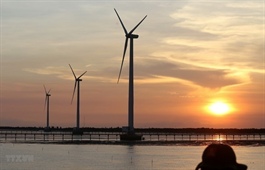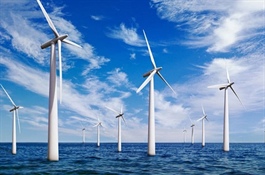Viet Nam has great potential for wind power: conference
Viet Nam has great potential for wind power: conference
Around 10 gigawatts of offshore wind power could be in operation in Viet Nam by 2030, according to studies carried out by the Danish Energy Agency and the World Bank.

The studies on the development of a new offshore wind sector by the Vietnamese Government were presented during a two-day international conference which wrapped up on Tuesday just ahead of the release of the new Power Development Plan 8.
With estimated potential of 160 gigawatts of offshore wind power within a distance of 5km to 100km from shore, Viet Nam has favourable conditions to create an offshore wind industry. The long coastline, ample wind resources and political will are key parameters to creating a green and forward-looking industry that can supply huge amounts of green electricity at attractive prices while creating new jobs and attracting investments.
At the conference, the consultants presented their studies on aspects including the assessment of potential and grid transmission capacity, the current local supply chain capacity, opportunities and challenges in offshore development, policy and management experience from countries with advanced offshore industry as well as recommendations for a roadmap to offshore wind power development.
The studies will be finalised taking into consideration the opinions and suggestions from the conference participants and will be submitted to the government of Viet Nam in the near future. The outcome of the conference will be an important input for shaping the policy targets in the Vietnamese national Power Development Plan 8, which is the most important policy guiding Viet Nam’s development in the energy sector in the next 10 years.
“The Government of Viet Nam is always committed to the development of a sustainable energy sector and the timing is critical to the preparations of the national Power Development Plan 8 by the Ministry of Trade and Industry (MoIT). We, therefore, highly appreciate advice and recommendations from Denmark and the World Bank, our long term partners who possess many years of experience and knowledge in renewable energy,” said Hoang Tien Dung, Director General of MoIT’s Electricity and Renewable Energy Agency.
The Danish Energy Agency and the World Bank Group presented key recommendations include clear, long-term and progressive capacity deployment targets, a sound legal framework and a financeable Power Purchase Agreement in line with international practices, mandate a government agency to act as a single point of contact to streamline the permitting and consent processes for offshore wind projects, thus ensuring timely delivery of projects and award of large-scale demonstration projects to be commissioned in phases in order to kick-start the sector.
“As Viet Nam is keen on moving towards a green transition of its energy sector, offshore wind power will definitely be one of the most cost-effective options as proven in many countries, including Denmark. A developed offshore wind industry will not only provide a new source of clean energy and contribute to climate change mitigation but also create a significant number of new jobs for local people while creating a new maritime economy and attracting significant new investments.
The final decision of course fully rests with the Government of Viet Nam, but Denmark, being a long-term and close partner with Viet Nam in the energy sector, is always willing to share knowledge, experience and best practices from our 30-year offshore wind development, as we did at this conference,” said Kim Højlund Christensen, Ambassador of Denmark in Viet Nam.
Director at the Danish Energy Agency, Anton Beck, said: “Offshore wind turbines represent the most potent renewable energy technology with just one 8-megawatt turbine being able to power annual electricity consumption corresponding to more than 43,000 Vietnamese households. We are happy to be able to share our vast Danish experience with offshore wind power with our close Vietnamese partners. Pressing ‘play’ has been underway for some time, and our Vietnamese partners are both eager to get going and determined to get it right."
“The World Bank studies show important economic benefits of deploying offshore wind at the scale of up to 10 gigawatts by 2030, which can render between 190,000-700,000 full-time years of employment. It will be important to take these considerations on board during the development of the National Power Development Plan 8,” said Rahul Kitchlu, Programme Leader for Infrastructure and Energy Sector Co-ordinator, World Bank.
The workshop also addressed a wide range of concerns regarding offshore wind development, ranging from the perspective of the developers, the supply chain as well as investor interests. The dialogue provided a holistic input to the future of Viet Nam’s offshore wind development.
The conference took place both off-line in Ha Noi and online through a video link between the capital city, Copenhagen and other locations around the world. It attracted broad participation of Vietnamese decision-makers and sector managers both at the central and provincial levels, international and local professionals from the offshore wind industry and supply chain, and the private sector.


























